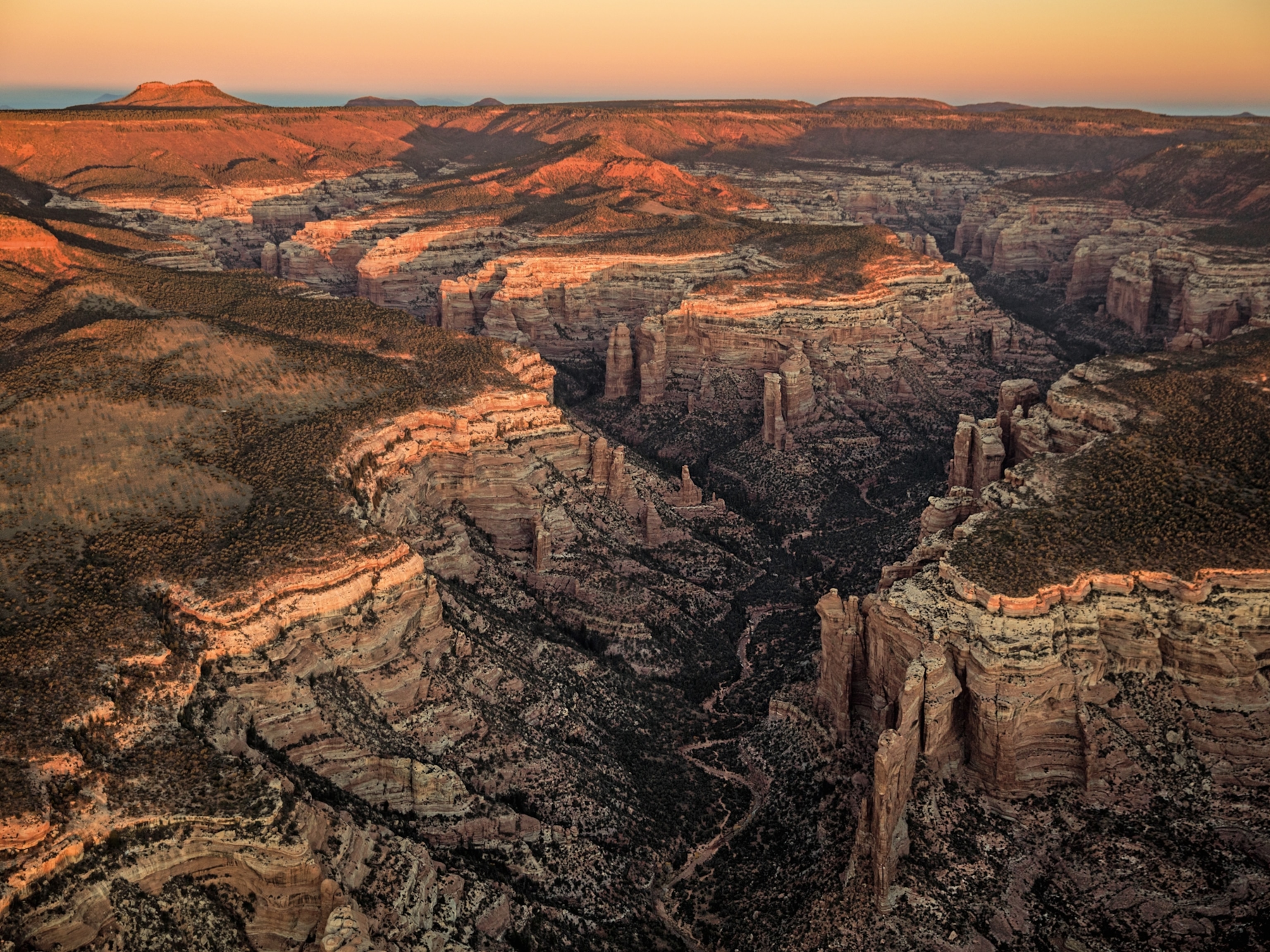
A View Inside the World of Garrison Keillor
Erika Larsen photographed Garrison Keillor’s hometown for “There’s No Place Like Home,” a personal narrative written by Keillor for the February 2014 issue of National Geographic magazine.
Included below are excerpts from emails sent from Keillor to Larsen, along with passages from Keillor’s essay for National Geographic. This is Larsen’s second assignment for the magazine. Her photographs of Scandinavia’s Sami Reindeer Herders were published in the November 2011 issue.

September 13, 2012
Dear Erika,
Glad to hear you’ll be shooting the “Personal Geography” story for National Geographic. . . . My wife Jenny and I would be happy to put you up in our large, suddenly empty (with our daughter off to boarding school) house in St. Paul. Queen bed, quiet, your own bath en suite, sunny terrace, free access to kitchen and grand piano, wi-fi, etc etc. Ten minutes from airport. Cat on the premises.
Talk to you soon.
Garrison Keillor
It was my first contact with Garrison and the start of my journey into his life. It would begin in October before the days got short and cold in the Twin Cities. I wanted to explore his memories, his past, to search for his ghosts, familiar and distant. I would use his words as a map. To try and understand Garrison I had to start from the beginning. Discover his childhood, his family, and his first dwellings.

I would visit his hometown, his family cemetery and relatives. I would attend several “meetings”—what church services are called in the Brethren community. I would attend Sunday school classes—the same classes that, to Garrison, made a boy “ever aware of worldly temptation.” I would read verses from the Bible in his mother’s home, the same book from which Garrison had to memorize a verse every Sunday.

I would drive down that long country road out West, leaving the Twin Cities, listening to his voice through the radio.
He called this piece “a memoiristic essay on life in a contained space.” I would try to find a way to penetrate that space and render it on film. I carried a few questions with me. Would the children of today echo the past? Had the landscapes bronzed his footsteps? Would the voices from beyond still have a form?

September 17, 2012
(Don’t you imagine you could do all the images in three days? You really need to return later? Well, you know what you want, I’m sure.) . . . It’s an odd piece to illustrate, for sure, since it’s nostalgic and personal, but the pictures needn’t be either. The challenge, as I see it, is to take a fairly ordinary midwestern city and to see it grandly and elegantly, and the legends (or captions) will try to populate the pictures with some chunks of narrative.
If I’m busy on the 10th, I may have my sister drive you around. She knows even more than I do.
Garrison

And he was right. It would be an odd piece to illustrate. I began in my home by reading excerpts from his books, watching a documentary of his life, and of course listening to A Prairie Home Companion. Most importantly, I would read and reread his story. My editor and I highlighted all the parts that had potential to be visually represented and I used this as a map. A map of not only geography but of time also.

I decided to divide the weeks I had available to shoot among the seasons. The seasons would become the backdrops for the scenes from his life that I would use to paraphrase 70 years into 12 pictures. January was the time to experience the Minnesota cold. How could I understand that “love blooms when it is coldest” without standing in blustering wind on frozen lakes in minus 30 degrees? I would be entranced by the light the full moon cast on “the brave little skyscraper” of his childhood—The Foshay Tower—that was at one time the tallest building in the Twin Cities. I would find myself timing my long-exposure images of the “Great River” by saying “one Mississippi, two Mississippi, three Mississippi.” I would eat at the White Castle after a long night out with the creative writing students from the university. The same university where, as a young man, he wrote “dense jagged unreadable poems” and discovered “girls with jiggly breasts under their aboriginal blouses, everyone skinny as snakes.”

September 17, 2012
Ten weeks!!!!!! TEN WEEKS????
I think you should make all the images you can in October, dear, because winter can be so unpredictable —- snow or not so much snow —- and spring is a complete mystery, sometimes there is one and other times not, and so you may not get decent shots until May. A long time.
. . .
See you soon, and let me know when your plane is coming in so we can fetch you at the airport.
Garrison

But I needed those weeks to have any chance of understanding spring’s mystery. I wanted to find the families gathering at Lake Calhoun, and scour the surrounding suburbs searching for the first rhubarb pie of the season. I would walk the streets at the old-time car show in Hastings searching for his first love: “Her at the wheel, the summer wind in my face, the lights of Minneapolis passing, sweet love in the air. I would give the world to go back to that night and hold her in my arms.” And I would need that time to attend his niece’s wedding. A stunning woman echoing the past yet fully ripe with the future. A lot of his family was in attendance. On my final flight from the Twin Cities back east I reread his essay for the final time, still wondering if I have any better understanding of his final words than I had a year ago.
“I was not a good person.
I have yelled at my children.
I neglected my parents and was disloyal to loved ones.
I have offended righteous people.
People around here know all this about me, and yet they
still smile and say hello, and so every day I feel forgiven.”

Garrison Keillor is an author, radio personality, and storyteller best known for his work on A Prairie Home Companion, a live radio variety show. The Keillor Reader, a collection of stories and essays will be published by Viking in May.
Erika Larsen studies cultures with strong ties to nature. Her 2009 magazine assignment on the Sami reindeer herders of Scandinavia grew out of her own documentary work, for which she lived and worked within the culture for over four years. View more of Larsen’s work on her website.
Related Topics
You May Also Like
Go Further
Animals
- What La Palma's 'lava tubes' tell us about life on other planetsWhat La Palma's 'lava tubes' tell us about life on other planets
- This fungus turns cicadas into zombies who procreate—then dieThis fungus turns cicadas into zombies who procreate—then die
- How can we protect grizzlies from their biggest threat—trains?How can we protect grizzlies from their biggest threat—trains?
- This ‘saber-toothed’ salmon wasn’t quite what we thoughtThis ‘saber-toothed’ salmon wasn’t quite what we thought
- Why this rhino-zebra friendship makes perfect senseWhy this rhino-zebra friendship makes perfect sense
Environment
- What La Palma's 'lava tubes' tell us about life on other planetsWhat La Palma's 'lava tubes' tell us about life on other planets
- How fungi form ‘fairy rings’ and inspire superstitionsHow fungi form ‘fairy rings’ and inspire superstitions
- Your favorite foods may not taste the same in the future. Here's why.Your favorite foods may not taste the same in the future. Here's why.
- Are the Great Lakes the key to solving America’s emissions conundrum?Are the Great Lakes the key to solving America’s emissions conundrum?
- The world’s historic sites face climate change. Can Petra lead the way?The world’s historic sites face climate change. Can Petra lead the way?
History & Culture
- Hawaii's Lei Day is about so much more than flowersHawaii's Lei Day is about so much more than flowers
- When treasure hunters find artifacts, who gets to keep them?When treasure hunters find artifacts, who gets to keep them?
- Meet the original members of the tortured poets departmentMeet the original members of the tortured poets department
- When America's first ladies brought séances to the White HouseWhen America's first ladies brought séances to the White House
Science
- Should you be concerned about bird flu in your milk?Should you be concerned about bird flu in your milk?
- Here's how astronomers found one of the rarest phenomenons in spaceHere's how astronomers found one of the rarest phenomenons in space
Travel
- Are Italy's 'problem bears' a danger to travellers?Are Italy's 'problem bears' a danger to travellers?
- How to navigate Nantes’ arts and culture scene
- Paid Content
How to navigate Nantes’ arts and culture scene - This striking city is home to some of Spain's most stylish hotelsThis striking city is home to some of Spain's most stylish hotels
- Photo story: a water-borne adventure into fragile AntarcticaPhoto story: a water-borne adventure into fragile Antarctica







